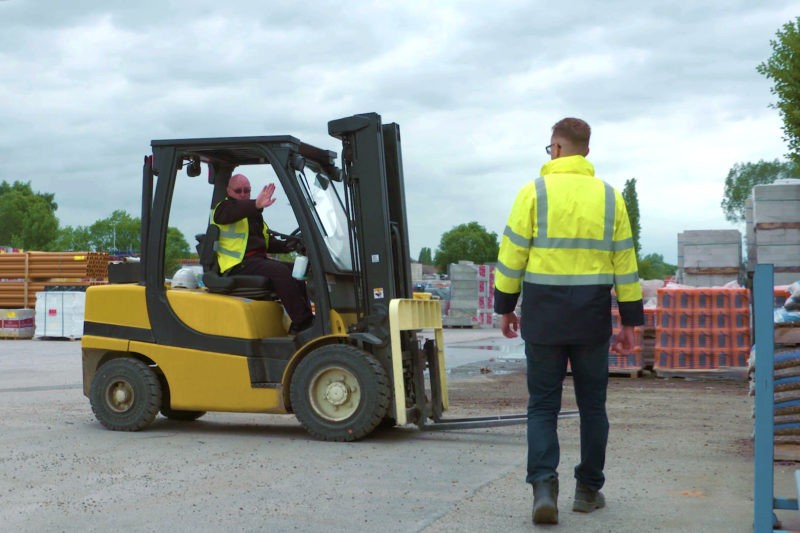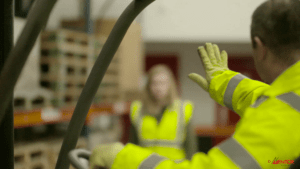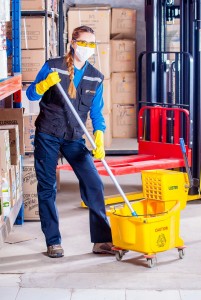
Tips to Help Manage Vibration and Prevent Cases of HAVS
Take the time today to ensure your company is up to speed with the legal requirements concerning vibration, and that you have put the necessary controls in place.
Contact us should you require guidance.
 Here we look at what we must do to keep forklifts and pedestrians apart.
Here we look at what we must do to keep forklifts and pedestrians apart.
Each year, 1,300 workers in the UK are seriously injured following accidents involving forklift trucks. Forklift truck accidents have revealed that nearly 75% of ‘impact with a third person’ events involve pedestrians that were completing tasks unrelated to the immediate truck operation at the time of their accident.
Wherever it is feasible to segregate your operating areas, it is best practice to do so. But how do we deal with areas that can’t be physically segregated? It’s here that life-changing accidents and injuries too often occur.
To try to minimise the risk, many companies opt for a generic safe distance rule across their entire site. This might be a set distance, or a minimum number of pick points that are expected to be maintained at all times.
But the danger of fixed-distance rules is that not all tasks carried out on your premises are the same, and neither are the associated risks. Every lift must be judged on its own merits, if the chance of an accident is to be adequately reduced. The best way to do this is via risk assessment, followed up with the relevant Safe Systems of Work.
Targeting the trend – lost loads
One recent trend in the news is those working alongside forklifts — often colleagues or delivery drivers — suffering life-changing injuries (or worse) as a result of a truck losing its load during operation. Many suffer crush injuries while trying to steady the load or get involved in the loading or unloading of their vehicle. Indeed, in one recent case, a delivery driver was fatally crushed when an overloaded forklift became unstable and tipped over, as no safe distance was kept between them.
Tragically, injuries to pedestrians caused by lost loads are almost always avoidable because the pedestrian should never need to be in the operating area in the first place. Should a forklift lose its load with no pedestrians in proximity, the worst-case scenario is damage to your stock or equipment. This is still an issue for budget-conscious businesses, but far preferable to the devastating consequences should a pedestrian become involved.
As stated earlier, nearly 75% of ‘impact with a third person’ events involve pedestrians on an unrelated task, but around half of the remaining pedestrian impacts are with delivery truck drivers not respecting safe working distances while their vehicles are being unloaded. In areas where physical segregation often isn’t possible, there need to be robust Safe Systems of Work in place to reduce the risk. These could include the following measures:
So when forklifts and pedestrians must operate in proximity, how close is too close? Well, there’s certainly no one-size-fits-all answer when it comes to safe operating distances.
A safe distance for your operations
The best approach is to create separate Safe Systems of Work for the different forklift operations carried out on your site, each taking into account the specific risks that the task presents. A good start is to consider the following:
Make sure a safe distance is kept between forklifts and pedestrians
Once you’ve assessed safe distance throughout your operations, the next step is to communicate it, and be sure to include everyone who may need to access an area where forklifts operate, however rarely this may be. This shouldn’t just include staff but also contractors and visitors, particularly delivery drivers whose vehicles become part of your operations during the loading/unloading process.

Remember, your safety measures are only effective if they’re being followed, so raising awareness and fending off complacency is key.
Not worth the risk
As someone responsible for health and safety, you’ll need no reminding of the implications if you and your organisation are found by the HSE to have failed to identify risks or provide adequate training and instruction. It could result in a hefty fine or even a jail term, but that pales into insignificance when compared with the devastating and life-changing effects a forklift-related injury can have on the victim along with their colleagues, family and friends.
Ultimately, as a manager or health and safety representative, it’s up to you to ensure staff follow processes and procedures that will keep them safe and your business compliant and efficient. But with the right policies, communication and guidance, you can take simple, practical steps towards developing a culture of personal responsibility, where everyone takes ownership of their own safety and that of those around them, to the benefit of everyone.
Contact us for further information.

Crush injuries and fatalities sustained from being trapped between two vehicles are all too common – take the time today to check your procedures are not putting your workers at risk. Continue reading
 The company wants to ensure that it is doing all that is reasonably practicable to eliminate and/or reduce the risks from vibration when using such tools in the workplace. Here is some guidance for helping employees in your organisation use hand-held power tools.
The company wants to ensure that it is doing all that is reasonably practicable to eliminate and/or reduce the risks from vibration when using such tools in the workplace. Here is some guidance for helping employees in your organisation use hand-held power tools.
The first step should be to formulate a policy, with the purpose to prevent, so far as is reasonably practicable, the risk of hand–arm vibration syndrome (HAVS) arising from the use of hand-held vibrating tools and equipment. It should include the following.
A risk assessment should identify the various sources and characteristics of the vibration hazard, including the number of employees at risk, allowing for an overall risk evaluation. Those tools or processes of greatest risk should be prioritised and addressed first. It is important that the person carrying out any such assessment is competent to do so.
The basic measures for reducing occupational exposure to hand-transmitted vibration are to eliminate/reduce vibration by using alternative methods or equipment. Vibration transmission to the hands can be reduced by using tools fitted with “anti-vibration handles”.
Organisation at work, job rotation and suitably timed rest breaks may help to reduce vibration exposure. However, it should be remembered that the mathematical relationship between vibration magnitude and exposure time means that a large reduction in time is required before any significant effect on vibration magnitude is seen and it should, therefore, be considered low down the hierarchy of control.
It is important to provide information to employees on the risks associated with hand-transmitted vibration, as well as information on signs and symptoms of HAVS and why these should be reported to their employer, or, if applicable, to the occupational health staff as soon as they are identified.
Employees should be instructed on the actions required to minimise the risk and ways in which they can contribute to risk reduction and control, for example by maintaining good blood circulation, warming both hands and body prior to starting work in cold conditions, keeping warm while working, ensuring that tools are properly maintained, and reporting defects.
Further preventive measures include regular maintenance of vibrating tools and equipment. Information on how to correctly maintain items can be provided by manufacturers or suppliers. It is of equal importance to replace worn parts, correct unbalanced equipment and maintain anti-vibration mounts and devices.
Contact us should you require assistance.
 Maintaining high levels of hygiene should be an essential element of how any workplace operates. As an employer, the Health and Safety at Work Act 1974 requires you to have a general duty to ensure the health, safety and welfare of all your employees, so far as is ‘reasonably practical.’
Maintaining high levels of hygiene should be an essential element of how any workplace operates. As an employer, the Health and Safety at Work Act 1974 requires you to have a general duty to ensure the health, safety and welfare of all your employees, so far as is ‘reasonably practical.’
The issue of hygiene is a part of this legislation, so you need to be sure you are providing the facilities and information for your employees to create a hygienic and clean workplace.
Why is workplace hygiene important?
There are potential dangers for any workplace if there is little or no emphasis on why hygiene is important. Primary among these risks is the possibility of infection, whether it’s through poor personal hygiene, slapdash office cleaning or badly managed washroom facilities. You can prevent many of these problems by having a strategy for maintaining a hygienic workplace.
Personal hygiene
This refers to the habits, cleanliness and appearance of your employees. It can be a sensitive area for employers and managers, so an official policy can diffuse any awkwardness by setting down exactly what is expected from everyone. Depending on your business, there may be options to provide shower facilities if employees exercise before work or rely on a bike for transport, and you can ask that hair washing and grooming facial hair is a part of usual personal hygiene for work. Hand washing and the use of hand sanitisers are also key tools to help prevent the spread of illness.
Washroom facilities
Your policy on hygiene requirements should ensure that washrooms equipped with running cold and hot water are provided for all employees. You should also provide hand soap, toilet paper and towels for drying hands. This allows employees to attend to their personal hygiene when they have finished using the facilities. If you contract the cleaning of toilets and washrooms to an outside agency, you should be clear about the levels of cleanliness you require and how often cleaning should be done.
Kitchen
Kitchens can be a health risk if proper cleanliness is not observed. Any area where food is prepared or hot drinks are made should have a high level of cleaning, including preparation surfaces, utensils and cups, mugs, plates and cutlery, where provided. Your employees are entitled to complain if they consider there is a health risk through poor maintenance and cleaning of the kitchen area, but you can also encourage them to take responsibility to protect themselves and practice a good hygiene regime.
Office cleanliness
Employees should be encouraged to be responsible for cleaning and maintaining their own work areas or workstation. This can be part of your hygiene policy so everyone is aware of it and agrees with it. Surfaces can be cleaned with disinfectant to reduce the possibility of bacterial infection, and desks should be kept tidy and as clutter-free as possible. If employees have individual bins, it’s important to ensure these are emptied on a daily basis.
Good hygiene makes good sense
When your employees are aware of why it is important to have a hygienic workplace, they are more likely to follow your policy guidelines and create a pleasant and safe environment in which to do their jobs. If everyone is vigilant, sickness levels in the workplace can be significantly reduced.
Contact us should you require assistance.